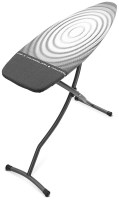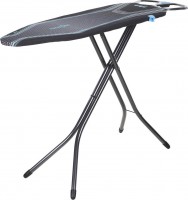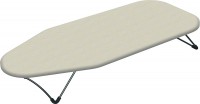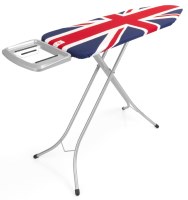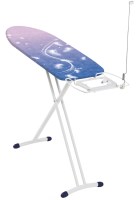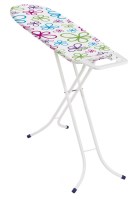Ironing Boards Brabantia
All Ironing Boards Advanced filters → |
You might be interested in
Articles, reviews, useful tips
All materials
Iron, steam generator or steamer: what to choose?
Let's figure out the differences between regular irons, irons with a steam generator and steamers, what are their pros and cons

What do the symbols on clothing labels mean?
Understanding the meaning of pictograms used for washing, spinning, drying, ironing, bleaching, and dry cleaning clothes
Ironing Boards: specifications, types
Type
The type primarily determines how the ironing board is installed.
— Floor. The most prevalent type today, notably because floor ironing boards are highly self-sufficient, eliminating the need for additional stands unlike tabletop boards. Despite slightly larger dimensions, primarily in thickness due to folding capability, the only noticeable drawback is a somewhat increased weight, which is hardly critical given that these boards are typically used indoors.
— Desktop. These boards, when in use, have a modest height and require an additional support like a table or workbench. They are lighter and more compact than their floor counterparts but lack the same versatility. However, desktop models prove invaluable in tight spaces where floor installation is not feasible.
— Built-in. These boards are intended for integration into furniture or wall niches, featuring a folding design that demands minimal installation space. When not in use, they neatly conceal inside a built-in box, saving room space. However, their installation is more complex compared to desktop or floor-standing models, and they are not designed for portability.
— Floor. The most prevalent type today, notably because floor ironing boards are highly self-sufficient, eliminating the need for additional stands unlike tabletop boards. Despite slightly larger dimensions, primarily in thickness due to folding capability, the only noticeable drawback is a somewhat increased weight, which is hardly critical given that these boards are typically used indoors.
— Desktop. These boards, when in use, have a modest height and require an additional support like a table or workbench. They are lighter and more compact than their floor counterparts but lack the same versatility. However, desktop models prove invaluable in tight spaces where floor installation is not feasible.
— Built-in. These boards are intended for integration into furniture or wall niches, featuring a folding design that demands minimal installation space. When not in use, they neatly conceal inside a built-in box, saving room space. However, their installation is more complex compared to desktop or floor-standing models, and they are not designed for portability.
Countertop material
The material from which the main working surface of the board is made.
— Wood. Ironing boards can be crafted from various wood types: natural wood, chipboard, or plywood. While natural wood offers greater durability, it can make boards heavy. Chipboard and plywood allow for lighter constructions, but they are less durable, prone to deformation from moisture and high temperature. This issue is also present, to a lesser extent, with natural wood. Consequently, wood is primarily utilized in low-cost-friendly models.
— Metal. Metal countertops typically feature a solid sheet with perforations for steam release, ensuring robustness due to the moisture-resistant alloys that resist deformation from iron's operating temperatures. However, these boards tend to be costly, and the longevity of the cover relies heavily on the quantity of holes—if too few, wear occurs more rapidly.
— Metal mesh. A "lighter" alternative to solid metal countertops is the grid design. While slightly less durable than solid sheets, grids still offer reliability and resistance to deformation. Moreover, they provide better steam passage and are lighter in weight.
— Thermoplastic. A special type of plastic, originally created as a material for ironing boards. With a small weight, it is resistant to heat and moisture, as well as good strength and reliability. The ma...in disadvantage of this material is its high cost.
— Wood. Ironing boards can be crafted from various wood types: natural wood, chipboard, or plywood. While natural wood offers greater durability, it can make boards heavy. Chipboard and plywood allow for lighter constructions, but they are less durable, prone to deformation from moisture and high temperature. This issue is also present, to a lesser extent, with natural wood. Consequently, wood is primarily utilized in low-cost-friendly models.
— Metal. Metal countertops typically feature a solid sheet with perforations for steam release, ensuring robustness due to the moisture-resistant alloys that resist deformation from iron's operating temperatures. However, these boards tend to be costly, and the longevity of the cover relies heavily on the quantity of holes—if too few, wear occurs more rapidly.
— Metal mesh. A "lighter" alternative to solid metal countertops is the grid design. While slightly less durable than solid sheets, grids still offer reliability and resistance to deformation. Moreover, they provide better steam passage and are lighter in weight.
— Thermoplastic. A special type of plastic, originally created as a material for ironing boards. With a small weight, it is resistant to heat and moisture, as well as good strength and reliability. The ma...in disadvantage of this material is its high cost.
Working surface size
The size of the main surface of the ironing board in length and width. The second size is usually indicated by the widest point, because most modern boards have a shape tapering towards one of the ends. The larger the working surface, the more convenient it will be to work and the greater part of the ironed product can fit on the board at a time. On the other hand, to install such a board, you will need the appropriate space, and this parameter also affects the cost.
Features
— Stand for iron. The presence in the design of a separate platform for placing an iron. Usually such a platform is made of heat-resistant materials (most often metal), which makes it possible to put a heated iron on it directly with the sole down. It's safer than placing it vertically on your work surface, and in most cases, it's also more convenient.
— Height adjustment. The ability to change the height at which the work surface is placed. This feature is almost a must for modern ironing boards. for people of different heights and the optimal height of the board will be different (and even for one person in different situations it may be necessary to rearrange the work surface higher or lower).
— Sleeve board. Availability in a set of delivery of a board of the adaptation for an ironing of sleeves. The undersleeve is usually a small, narrow and long area of the same material and with the same finish as the main work surface. It can either be fixed on the board or be a completely independent device with the ability to install on any flat surface.
— Linen shelf. The presence in the design of the board of its own shelf for placing linen. Thanks to it, you do not have to unload each ironed item from the board separately: you can put several items in a pile on a shelf, and then move the entire pile to a place...of permanent storage (for example, in a closet).
— Holder for hangers. The presence in the design of the ironing board of special devices for placing coat hangers. Mostly it is a removable metal arc, with recesses for attaching hangers.
— Built-in socket. Some models come with a built-in outlet for connecting the iron, essentially acting as an extension cord. This design allows for more flexibility in placement, especially in tight spaces where positioning the board near a wall outlet might not be feasible.
— Wire holder. The iron typically comes with a wire holder—a vertical metal "antenna" around 30 cm tall, with a spiral at the end serving as the actual holder. This design enhances convenience and safety by preventing wire tangling under hands and minimizing the risk of the cord getting under the hot soleplate and damaging insulation.
— Steam absorption function. This feature eliminates excess steam produced during steam ironing or while working on damp fabrics, ensuring that the ironed items remain as dry as possible. To manage the expelled steam, these boards typically include a ventilation function.
— Ventilation function. This function is performed by a system enabling air circulation within the board's working surface. This system offers two modes: the first gently "inflates" the cover, ideal for delicate fabrics, while the second, the blowing mode, is primarily employed to eliminate excess steam in boards with the respective function mentioned earlier.
— Heating of an ironing surface. The ironing board incorporates a heating system within its work surface to enhance heat provision. This allows simultaneous ironing on both sides, expediting the process and intensifying heat, particularly beneficial for drying damp laundry or ironing thick items that would otherwise require flipping to treat both sides.
— Foot control. A floor pedal that controls a specific function of the board, such as ventilation or heating of the work surface. Such control is convenient in that it does not require the use of hands — thus, you can turn on and off the corresponding function of the board without letting go of the iron and not being distracted from ironing.
— Transport rollers. As the ironing board is frequently moved from the workspace to storage, having wheels simplifies this process. Considering that the iron is typically used by individuals, particularly women, the addition of wheels enhances convenience when handling the board.
— Height adjustment. The ability to change the height at which the work surface is placed. This feature is almost a must for modern ironing boards. for people of different heights and the optimal height of the board will be different (and even for one person in different situations it may be necessary to rearrange the work surface higher or lower).
— Sleeve board. Availability in a set of delivery of a board of the adaptation for an ironing of sleeves. The undersleeve is usually a small, narrow and long area of the same material and with the same finish as the main work surface. It can either be fixed on the board or be a completely independent device with the ability to install on any flat surface.
— Linen shelf. The presence in the design of the board of its own shelf for placing linen. Thanks to it, you do not have to unload each ironed item from the board separately: you can put several items in a pile on a shelf, and then move the entire pile to a place...of permanent storage (for example, in a closet).
— Holder for hangers. The presence in the design of the ironing board of special devices for placing coat hangers. Mostly it is a removable metal arc, with recesses for attaching hangers.
— Built-in socket. Some models come with a built-in outlet for connecting the iron, essentially acting as an extension cord. This design allows for more flexibility in placement, especially in tight spaces where positioning the board near a wall outlet might not be feasible.
— Wire holder. The iron typically comes with a wire holder—a vertical metal "antenna" around 30 cm tall, with a spiral at the end serving as the actual holder. This design enhances convenience and safety by preventing wire tangling under hands and minimizing the risk of the cord getting under the hot soleplate and damaging insulation.
— Steam absorption function. This feature eliminates excess steam produced during steam ironing or while working on damp fabrics, ensuring that the ironed items remain as dry as possible. To manage the expelled steam, these boards typically include a ventilation function.
— Ventilation function. This function is performed by a system enabling air circulation within the board's working surface. This system offers two modes: the first gently "inflates" the cover, ideal for delicate fabrics, while the second, the blowing mode, is primarily employed to eliminate excess steam in boards with the respective function mentioned earlier.
— Heating of an ironing surface. The ironing board incorporates a heating system within its work surface to enhance heat provision. This allows simultaneous ironing on both sides, expediting the process and intensifying heat, particularly beneficial for drying damp laundry or ironing thick items that would otherwise require flipping to treat both sides.
— Foot control. A floor pedal that controls a specific function of the board, such as ventilation or heating of the work surface. Such control is convenient in that it does not require the use of hands — thus, you can turn on and off the corresponding function of the board without letting go of the iron and not being distracted from ironing.
— Transport rollers. As the ironing board is frequently moved from the workspace to storage, having wheels simplifies this process. Considering that the iron is typically used by individuals, particularly women, the addition of wheels enhances convenience when handling the board.
Max. height
The highest height from the floor or table (depending on the type, see above) at which the working surface of the board can be placed in the unfolded state. If the design does not provide height adjustment (see "Features"), then this parameter is also a standard working height.
If you have experience using ironing boards and know what height is most convenient for you, you can easily choose the best option for this parameter.
If you have experience using ironing boards and know what height is most convenient for you, you can easily choose the best option for this parameter.
Minimum height
The lowest height from the floor or table (depending on the type, see above) at which the working surface of the board can be placed in the unfolded state. Along with the maximum height (see above), this parameter determines the working height range of a particular model; knowing this range, you can estimate how comfortable it will be for you.


